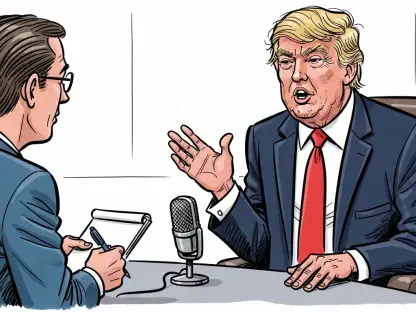With a reputation for pushing boundaries and challenging conventional norms, Elon Musk embarked on an audacious venture as he spearheaded a significant reform within President Trump’s administration. This initiative aimed at restructuring the federal government by establishing a new agency, the Department of Government Efficiency (DOGE). This move sought to eliminate redundancies, reduce costs, and streamline governmental operations, yet it invited substantial controversy and political dispute. Musk’s profound influence and the sweeping nature of the changes led to a heated debate over the impact on the traditional landscape of federal operations.
The Role and Impact of DOGE
Strategic Operational Restructuring
Under the leadership of Elon Musk, the Department of Government Efficiency (DOGE) was tasked with implementing a strategic agenda focused on drastic cost-cutting and redefining operational frameworks within federal agencies. Musk’s vision included a complete overhaul of existing protocols, driving the integration of his trusted aides into pivotal roles within the government. This approach was designed to secure long-lasting amendments that would transcend his immediate involvement and align with his philosophy for efficiency and innovation. The restructuring efforts were far-reaching, intending to create a leaner and more agile government apparatus capable of responding swiftly to new challenges.
DOGE’s mandate involved the introduction of new methodologies for financial management, data processing, and personnel administration, which were pivotal in determining the efficiency of federal functions. The department’s disruptive approach resulted in the termination of over 100,000 federal employees, significantly impacting sectors such as public health and diplomacy. By altering the dynamics within these agencies, DOGE initiated a new era characterized by streamlined processes and reduced bureaucratic barriers. The reform has, however, sparked intense debate over its implications for governmental stability, with critics arguing that the rapid changes fostered chaos and jeopardized the efficacy of essential public services.
Influence on Agency Operations
The extensive access granted to DOGE allowed it to infiltrate and influence the operational mechanics of key government agencies. The department’s efforts to streamline processes extended to various domains, impacting the way agencies manage payments, safeguard personal data, and implement personnel protocols. Such influence reshaped the foundational elements of numerous government operations, ushering in an era marked by significant transformations. While the intention was to drive efficiency, some argue that these changes undermined the foundational stability of long-standing bureaucratic systems and eroded essential public functions.
As DOGE navigated the intricacies of federal operations, its methods and practices came under scrutiny for challenging established norms. The impact on agencies like the Department of State and the Centers for Disease Control and Prevention was particularly notable, where vital programs and initiatives experienced shifts in priority and focus. The rapid restructuring often led to uncertainty and disruption within agencies, prompting concerns about the continuity and reliability of critical services. Although DOGE’s agenda was rooted in efficiency, the broader consequences of its actions highlighted the complexities associated with implementing large-scale institutional changes. The ensuing debates underscored the delicate balance between modernization and preserving the foundational integrity of government structures.
Political Response and Repercussions
Growing Political Backlash
The sweeping personnel cuts and restructuring initiatives orchestrated by DOGE ignited a political backlash reminiscent of conservative movements opposing previous administrations. The severity of DOGE’s actions, particularly the drastic reduction in the federal workforce and budget reallocations, became a rallying point for critics. Many Democrats found in these actions a compelling narrative to challenge the administration, citing concerns over undermined governance and accountability. The fervor of political opposition underscored a broader dissatisfaction with the perceived overreach of Musk’s authority and the consequential implications for public services.
As tensions within the political landscape intensified, DOGE’s reforms became central to legislative battles and electoral campaigns. Democrats, advocating for transparency and traditional governance approaches, used DOGE’s reforms as a springboard to galvanize support and push for legislative intervention. The resulting debates over the legitimacy and efficacy of DOGE highlighted a growing divide among legislators regarding the direction of national governance. For Republicans, rallying to defend the administration, the challenge was to validate the strategic necessity and intended benefits of DOGE’s agenda while countering narratives of governmental instability. As these dynamics unfolded, the restructuring initiatives of DOGE became emblematic of broader ideological divides, reinforcing the intersection of policy-making and political strategy.
Contentious Budgetary Claims
Elon Musk’s ambitious projection to slash $2 trillion from the federal budget became a focal point of critique as DOGE’s actual financial outcomes came under scrutiny. While the reform was billed as a fiscal revolution, intended to transform the federal budgetary landscape, skeptics began to question the authenticity of the claimed savings. The financial reconfigurations orchestrated by DOGE were argued to have resulted in unforeseen fiscal chaos rather than substantive improvements in efficiency. Critics pointed out that the methodologies employed often merely shifted financial burdens elsewhere within the federal apparatus, without achieving true reductions in expenditure.
The contentious budgetary claims fueled a broader narrative questioning the legacy and effectiveness of DOGE’s strategies. Financial analysts highlighted the discrepancies between anticipated and realized savings, arguing that the recalibrations resulted in disruptions to financial plans and strained existing resources. The perception that DOGE’s cuts were superficial rather than transformative added to the narrative of fiscal mismanagement, prompting calls for greater accountability. As discussions around the fiscal impact of DOGE continued to unfold, the broader implications of Musk’s reformative drive began to draw attention, spotlighting the nuanced challenges of implementing sweeping budgetary changes in a complex federal ecosystem.
Legal and Ethical Challenges
Controversial Methods Under Scrutiny
DOGE’s aggressive approach to reform, including the cancellation of numerous federal contracts, drew widespread criticism and legal challenges. The methods employed by the department were perceived by many as a reallocation of funds rather than substantive savings, prompting questions about the ethical and legal propriety of such practices. The perceived encroachment on established contracts led to significant controversy, as various stakeholders contended that these actions undermined long-term planning and financial stability within federal agencies. The ensuing legal battles reflected a deep-seated tension between innovation-driven reforms and the traditional regulatory frameworks that govern federal operations.
Stakeholders within and outside government voiced concerns over DOGE’s authority to implement such changes without broader consensus or compliance with established procedures. Over 100 lawsuits were filed challenging DOGE’s actions as exceeding its legal mandate, reflecting a broader apprehension about the balance between governmental innovation and adherence to legal norms. The contested practices brought to light complex ethical considerations about governance, program continuity, and contractual integrity. These legal proceedings underscored the importance of nuance and caution when implementing transformative changes within large bureaucratic systems, emphasizing the need for stakeholder engagement and legal foresight in reformative agendas.
Agency Upheaval and Employee Relations
The sweeping reforms executed by DOGE led to significant disruptions across various federal agencies, fueling fears of sustained service interruptions and thereby impacting employee morale. Agencies like the United States Agency for International Development (USAID), the Consumer Financial Protection Bureau (CFPB), and the Internal Revenue Service (IRS) were particularly affected, as drastic changes in personnel and priorities catalyzed shifts in operational focus. The indiscriminate nature of employee reductions exacerbated these tensions, contributing to a climate of uncertainty and insecurity among federal employees who feared further layoffs and restructuring waves.
DOGE’s initiatives extended beyond mere structural changes, as exemplified by the “Fork in the Road” email campaign, which aimed at incentivizing voluntary employee exits through strategic buyouts. This approach proved divisive, fostering apprehension and mistrust among staff as the emphasis on workforce reduction threatened the stability and efficacy of crucial agency functions. Employees grappled with the prospect of diminished roles and uncertain futures, prompting concerns about DOGE’s long-term viability and impact on federal capabilities. As the aftermath of these upheavals continued to reverberate, the broader conversations on employee relations highlighted the human dimension of administrative reforms and underscored the essential balance between efficiency and worker welfare.
Long-Term Implications of Musk’s Influence
Enduring Structural Changes
As Elon Musk plans to curtail his active involvement with DOGE, the structural changes initiated under his leadership suggest that his influence will endure long after his departure. The integrated presence of Musk’s allies in critical governmental roles ensures the perpetuation of DOGE’s agenda, embedding the department’s reforms into the fabric of federal operations. This embedding poses a unique challenge for future administrations attempting to navigate and possibly reverse these entrenched policies. As such, the transformations sparked by DOGE are poised to have a lasting impact on the operational dynamics and cultural ethos of the U.S. government, setting a precedent for efficiency-driven reform.
The potential long-term implications of DOGE’s activities include a reshaped understanding of federal agency operations characterized by increased autonomy, streamlined decision-making, and a focus on technological integration. However, the sustainability and adaptability of these changes remain subjects of considerable debate. Proponents argue that these reforms lay the groundwork for a modern, agile government aligned with contemporary challenges. In contrast, detractors contend that the foundational disruptions risk eroding public trust and undermining the necessary roles of bureaucracy and institutional knowledge. As the legacy of Musk’s involvement with DOGE continues to unfold, its enduring influence on governmental frameworks presents both opportunities and challenges for future policy architects.
A Political Battlefield
Widely known for his willingness to push boundaries and challenge conventional norms, Elon Musk took on a bold new initiative by pursuing significant reform within President Trump’s administration. Musk led the charge for creating a new branch of government, the Department of Government Efficiency (DOGE). This new department was intended to tackle redundancies, cut down on unnecessary expenses, and make government processes more streamlined and effective. However, this ambitious proposal didn’t come without its share of controversy and political debate. The proposed changes stirred up discussions about their potential effect on the established functioning of the federal government. Musk’s significant influence and the broad scope of the proposed reforms sparked heated debate, highlighting the ongoing tensions between innovation and tradition in government operations. Critics were wary of how these changes might alter the traditional landscape of federal processes, while proponents argued for the necessity of modernization. Ultimately, the controversy highlighted the complexities involved in reshaping long-standing governmental structures to better meet contemporary needs.









